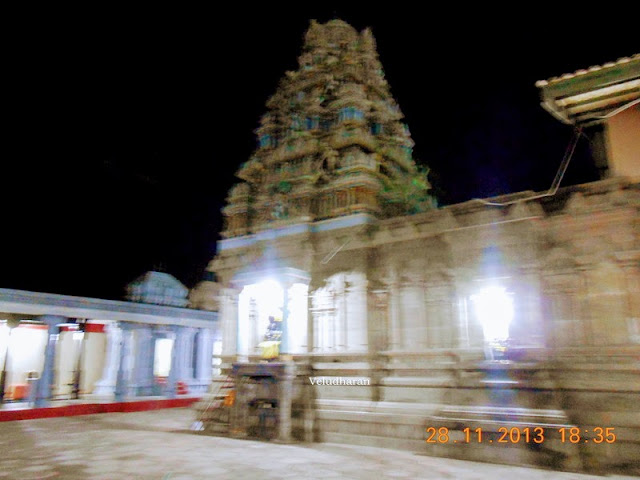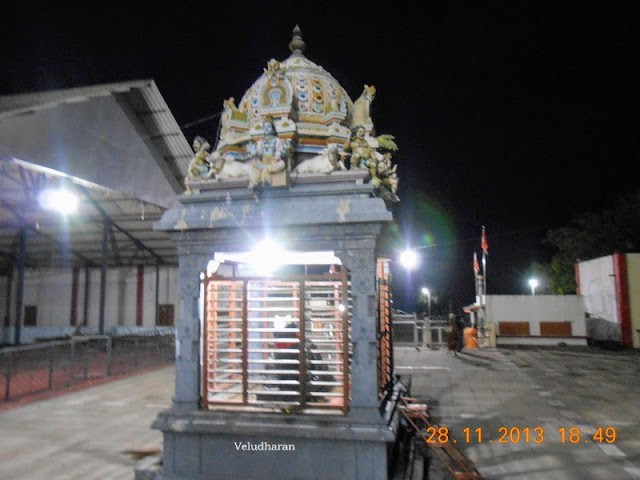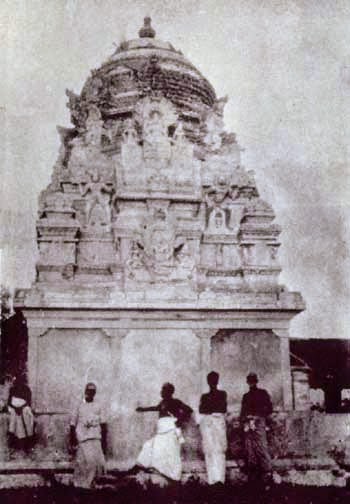This is
the 274th Thevaram Paadal Petra Shiva Sthalam and 2nd
Sthalam of Eezha Nadu also known as Sri Lanka. This is one of 5 Temples ends
with Ishwarams dedicated to Lord Shiva of Sri Lanka The other temples are Koneswaram
(Trincomalee), Naguleswaram (Keerimalai), Tenavaram ( Tevan Thurai ) and
Munneswaram ( Puttalam ). These are very popular even before the arrival of
Vijaya in 600 BCE. Literary evidence are there about the existence of this 5
temples in Sri Lanka.
In
Periyapuranam, Sekkizhar records that both Thirugnanasambandar and Sundarar has
sung hymns in praise of Lord Shiva of Thiruketheeswaram and Trincomalee temples
from Rameshwaram.
அந்நகரில்
அமர்ந்து அங்கண் இனிது மேவி ஆழிபுடை
சூழ்ந்து ஒலிக்கும் ஈழம் தன்னில்
மன்னு
திருக்கோணமலை மகிழ்ந்த செங்கண் மழவிடையார்
தமைப்போற்றி வணங்கிப் பாடிச்
சென்னிமதி
புணைமாட மாதோட்டத்தில் திருக்கேதீச்சரத்து அண்ணல் செய்ய பாதம்
உன்னி
மிகப்பணிந்து ஏத்தி அன்பரோடும் உலவாத
கிழிபெற்றார் உவகை உற்றார்
Thirugnanasambandar,
Sundarar and Ramalinga adigalar has sung in praise of Lord Shiva of this
temple.
பண்டு
நால்வருக்கு அறம் உரைத்தருளிப் பல்லுல கினில் உயிர் வாழ்க்கை
கண்ட நாதனார்
கடலிங்கை தொழக்காதலித் துறை கோயில்
வண்டு
பண்செய்மாமலர்ப் பொழின் மஞ்சை நடமிடு மாதோட்டம்
தொண்டர்
நாடொறும் துதிசெய அருள் செய் கேதீச் சரமதுதானே
........ திருஞானசம்பந்தர்.
அங்கத்துறு
நோய்கள் அடியார் மேல் ஒழித்தருளி
வங்கம் மலிகின்ற
கடன் மாந்தோட்ட நன்னகரில்
பங்கஞ்செய்த
மடவாளொடு பாலாவியின் கரைமேல்
தெங்கம் பொழில்
சூழ்ந்த திருக்கேதீச்சரத்தானே”
.......
சுந்தரர்
-“வேட்டுலகின்
மூதிச் சரமென்று
முன்னோர் வணங்கு திருக்
கேதீச்
சரத்திற் கிளர்கின்றோய்”
......திரு
அருட்பா.
Moolavar : Sri Thiruketheeswarar
Consort
: Sri Gowriambal.
Some of
the salient features of this temple are …...
The
temple is facing east with a 5 tier Rajagopuram on the east. Balipeedam, Rishabam and Dwajasthambam
are in front. At the entrance of Rajagopuram the old Nandhi and Ganapathi
and Subramaniar sannidhis. Adhikara Nandhi is on left side of
RajaGopuram.
In the
inner prakaram sannidhi for Suriyan, Storage place, Yaga
salai, Thirugnanasambandar, Ketu, Santhanasiriyars, Thirumuraigal,
Chatur Vedas, Urchava murtis of Nalvar, Sekkizhar
Peruman, 63var, Sundarar. Next is Vinayagar, Somaskandar,
Vishnu, Mahalingam ( He was once a moolavar who was damaged during excavation
), Subramaniar, Deva Saba, Saraba Moorthy,
Nataraja, Yaga salai, Bhairavar, Saneeswaran and Chandran.
Navagrahas
are in a Nirutha mandapam. Ambal Sri Gowri Ambal is facing south. The temple
has 5 Chariots, of which moolavar’s is of big.
There
are lot of madams on the east street some of them are
Thirugnanasambandar madam, Sundarar madam, Nattukottai Chettiars madam, Amma
madam, Pasumadam, Poonagariyar madam, on south street Swamy madam, Sivarathri
Madam, Nesavu madam, Sthapathis madam, on the west street Gurukula madam
and on North street Navalar madam, Vishwakarma madam, Thirukkuripu
Thondar madam, Annadhana mandapam.
HISTORY
This
temple is on north part ( North Province ) of Sri Lanka at Maanthai alias
Maathotta nagar on the banks of Pallavi river ( Now it has become like a lake )near
Mannar. Once it was a port, used for business by the Greeks, Romans, Arabians,
etc,. Maha Dhuvatta a deva thachan worshiped Lord Shiva of this temple, hence
this place was called as Mahadhuvatta puram and latter called as Mathottam.
Also Manthai originally came from Maha Sandhai ( மகா சந்தை -
a daily or weekly or monthly or yearly held market place is called
as sandhai )
As per
the Govt of India website, this is one of the Five Ishwarams dedicated to Lord
Shiva, venerated by the saivites of the subcontinent. Government of India was
in the process of restoring this temple under the Indian grant assistance of
LKR’s 326 million through the assistance of Archaeological Survey of India (
ASI ) and the College of architecture of Mamallapuram. This was published in
the year 2012. The works might have been completed in 2020..?
The
temple was completely destroyed by the Portuguese and was reconstructed
latter. Next to this are the Pappa Mottai, Maaligai Thidal,
Vettaiyamurippu, Kovilkulam, Paddy field, Coconut trees etc,. During Chozhas
Period, Chozha King Rajarajasekaran’s son Rajendran called this place as
Arunmozhitheva Valanadu. Also called as Man Thottathu Rajarajapuram. The Place
Pappamottai once was a raised land occupied by the Brahmins who had done pujas
to this temple and the Vettaiyamurippu was used for conducting
Thirukethareeswarar’s Vettai thiruvizha.
The
inscriptions got from the old temple site records the Chozha’s contributions to
this temple. In addition to this the inscriptions at Chidambaram temple also
throws some light about the thiruppani done by the Pandya King Sundarapandian
to this temple.
The
temple was once under the control of Chingaiyaria Kings who also controls
the Rameswaram of Tamil Nadu.
The
temple was completely destroyed by the Portuguese and poojas are terminated since
1589 CE. The stones removed from the temple was used for the construction of
Mannar Fort.
Even
though the temple was destroyed the murtis / idols were safely buried under the
earth. This was informed by Sri la Sri Arumuga Navalar who lived in the
year 1872, through bit notices and he was the instrumental behind the bringing
out of the temple details to this world after it was destroyed. With his
effort, a small shrine was built in the year 1910. The Palavi theertha was
restored in 1949. A Major effort was made to complete the temple in the year
1976.
The
temple is constructed in a 43 acres of land through an open auction to Rs
3100.00 by Thiru Rama. Aru. Palaniappa Chettiar from the British Governor U
Willams Duvanaima Durai in a postponed 2nd time auction on 13-12-1893 (
First time went up to Rs 3050, which the Saivaites could not mobilize the money
and was asked by Christians ).
The
important people involved in reconstruction of this temple are Palaniappa
Chettiar, Pasupathi Chettiar, Neeraviyadi Vai. Arumugam, Vaithiyar Ramu
Pillai, Raghava Pillai from Tamil Nadu and Latter for thirupani
Somasundaram Chettiar ( 1952 ) of Kulasekarapattinam,
During
reconstruction the old sanctum sanctorum, Artha mandapam, Balipeedam,
Dwajastham installed places were unearthed. Damage occurred for the moola
Lingam ( Maha lingam ) during excavation was installed in the prakaram. The
estimated cost of the temple was Rs 22000 for moolavar and Ambal sannadhis.
Kumbhabhishekam
were performed during 1903, 1910, 1948, 1956 ( Sri Somasundaram Desikar,
Madurai Aadheenam and Polioli Sivapatha Sundaram are
responsible ), 1960 ( Sri la Sri Arumuga Navalar’s student Kasi vasi
Senthilnatha Iyer with the help of Tamil nadu’s
Sthapathis thirupani ), 1971 and 1976 in various stages and in 2020
( 10th June 2020 ).
From
14-09-1956, the responsibility of maintenance of this temple was transferred to
Eelam Sivanadiyar from Nattukottai Chettiars. But still Chettiars
participation is there.
The
Somaskandar is the largest in the world and was made at Ketheeswaram it self.
The idol was made of panchalogam ( 5 metals ) of which nearly 112 grams
of gold was added.
For this
temple’s Devara Thirupathigam meanings are written by Sri Ponnambalam Pillai,
the son in law of Sri la Sri Arumuga Navalar. Malaysia Tamilars, Yazhpanam
periyava Vasuvappa, Ponnili Udayar, Arulambalam, Mannar Asst Govt official
Arumugam are responsible for thirupani to this temple.
( The
Details were taken from the Temples' book released during recent
Kumbhabhishekam, Paadal Petra sthalangal details book written by Thiru Pu. ma.
Jaya Senthilnathan of Kanchipuram Sankara Mutt and during actual visit to this
temple ).
LEGEND
The Lord
was worshiped by Kethu, Maha Dhuvatta, Sri Ramar, Agasthiyar, Ravanan. Since
Kethu worshiped, the temple was called as Thiruketheeswaram ( “செய்ய கேது தலையற்ற அந்நாள் திருந்து பூசனை செய்து
முடிப்போன்”).
It is
said that the sage Agathiyar came to sri Lanka as a part of Pilgrimage to
Shiva temples. He worshiped Lord Shiva of this temple before proceeding to
dakshina Kailash ( Koneswaram ).
The
Skanda purana narrates the religious importance in Ceylon and the story of Thiruketheeswaram.
It also narrates the competition held between Vayu and Adiseshan to prove who
is great. When Adiseshan holds the Mount meru, Vayu tried blew it. In the process three peaks had fallen on the
earth. This one is called as Thiruketheeswaram. It is believed that, out of
most sacred Shiva temple two are in Sri Lanka and the rest are in India.
POOJAS AND
CELEBRATIONS
Apart from regular poojas, special poojas are
conducted on Maha Shivaratri day. Thousands of Devotees used to bring water
from Palavi river and do abhishekam to Lord Shiva. Theertha Kavadi is a special
ritual carried out in this temple.
POOJA TIMINGS
The temple will be kept opened between 07.00 hrs
to 11.30 Hrs and 15.30 hrs to 20.00 hrs.
The Dress code for Gents is dhoti to enter in to
the ardha mandapa.
CONTACT
DETAILS
The Temple can be reached +94 232 050 800 for
further details.
HOW TO REACH
Thiruketheeswaram temple is about 8.7 KM from
Mannar, 72 KM from Vavuniya, 109 KM from Jaffna, 110 KM from Anuradhapura, 169
KM from Trincomalee and 307 KM from Colombo.
Nearest airport is Colombo, nearest Railway
station is Thalai Mannar.
PC Website
PC Web site
PC Web site
PC Web site
An Old Photograph - PC Website
Old Photograph - PC Website
--- OM SHIVAYA NAMA ---







































